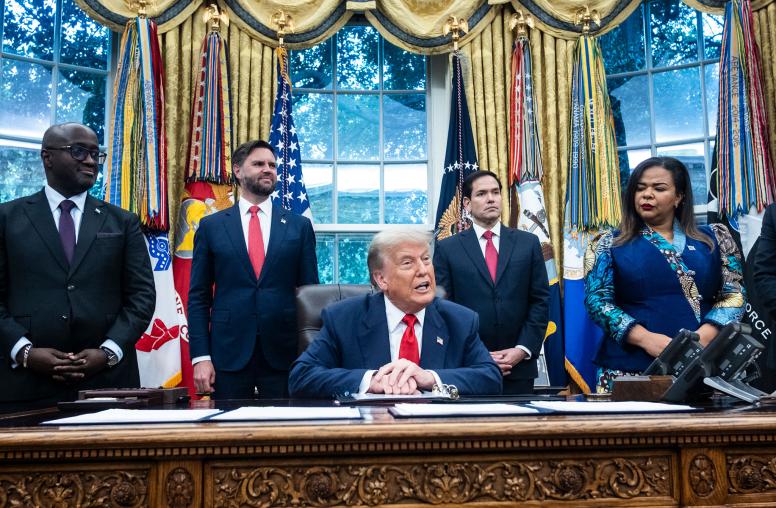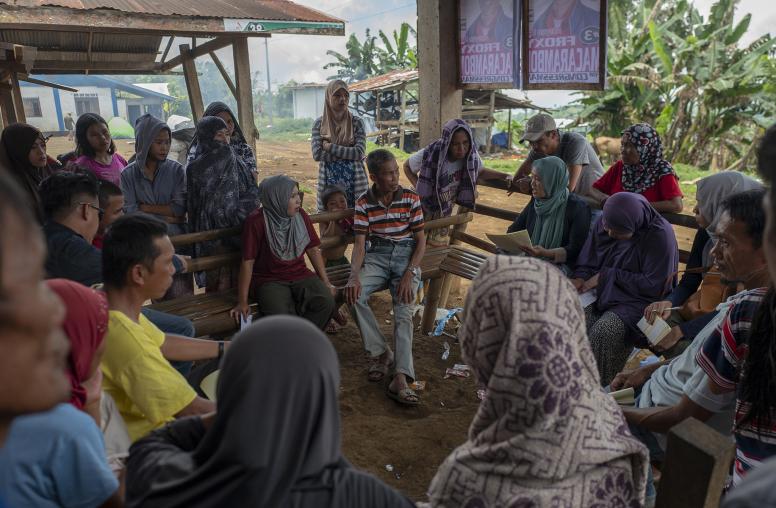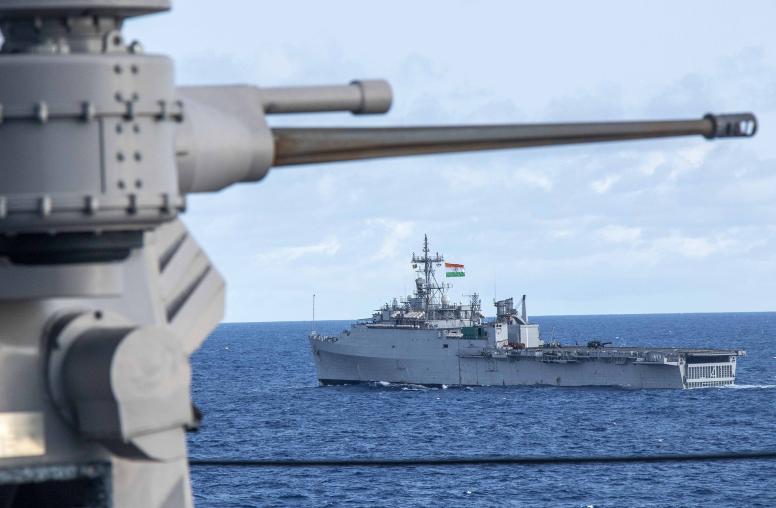Rethinking the War on Terror
USIPeace Briefing exploring the nature of Islamist militancy and how best to overcome it.
The U.S. Institute of Peace in engaged in a number of activities related to countering the global threat of terrorism. The following USIPeace Briefing explores the nature of Islamist militancy and how best to overcome it. The views expressed are their own and do not express the views of the Institute, which does not take policy positions.
I. Defining a New Strategic Challenge
Four years after 9/11, we are still trying to grasp the nature of the new strategic challenge we face and how best to counter it. The lack of consensus about what to call the threat underscores our difficulties. Is it "global terrorism," "Islamic terrorism," "al-Qaeda and its affiliates," "Sunni jihadists," or "terrorist extremism?" The issue is not merely one of semantics. Labels have vital operational import; concepts have action consequences. Clarity and consensus in understanding our security threat is essential to developing a comprehensive long-term strategy to meet the challenge.
Our preference is to classify this challenge as "Islamist militancy." Like the 9/11 Commission, we employ the modifier "Islamist"—underscoring the political nature of this movement within the Muslim world—as distinct from "Islamic," the culture and religion of Islam. Unlike the 9/11 Commission, however, we prefer the simpler, less loaded term "militancy" to "terrorism." "Militancy" encompasses those who employ or espouse violent means in pursuit of political ends, but avoids the notoriously slippery definitional problems associated with "terrorism." The term also serves to underscore that the challenge is multi-dimensional, encompassing more than just those who actually carry out terrorist attacks. We also recognize that there are peaceful Islamist organizations that reject violence and assert their desire to work within political systems.
The recent terrorist attacks in London, Madrid and elsewhere underscore the dynamic and unpredictable nature of this phenomenon, which is often the activity of a diffuse, nebulous set of actors whose identity and organizational structure are difficult to identify. Islamist militancy, by its nature, is more difficult to comprehend, predict and assess than state-derived threats. It is constantly evolving, feeding off a variety of conditions in the Muslim world and justified with the complex overlay of religion.
The phenomenon of Islamist militancy comprises three main constituent groups whose memberships are constantly evolving and overlap in significant ways. These groups are: first, transnational jihadist organizations with a global agenda (principally Al-Qaeda and its affiliates); second, the nationalist insurgent groups with a local agenda (for example, Hamas, Hizballah and some of the Kashmiri groups); and third, the myriad groups and networks that directly and indirectly support these organizations. Distinctions among these groups are increasingly difficult to discern.
Conventional counterterrorism measures, with their emphasis on leadership targeting, disabling networks and intelligence sharing are important but inadequate responses to the threat posed by these groups. We need an unconventional concept to organize a complex response to a complex phenomenon. Military force is sometimes necessary, but cannot serve as the exclusive focus of our response.
Given the dynamic, unpredictable nature of Islamist militancy, we are drawn to an "epidemic" conception as a way of thinking—and acting—in response to this threat. This approach draws on the scientific principles and practices of epidemiology as well as insights from a growing body of research on social contagion phenomena such as fads, rumors, and civil violence. Indeed, social scientists increasingly look to epidemiology to understand a variety of contagions, and here, Islamist militancy is no different.
Many commentators have employed disease metaphors to describe the challenge of Islamist militancy. References to terrorism being a "virus" or al Qaeda "mutating" or "metastasizing" are common. Similarly, madrassas and mosques are described as "incubators" of a "virulent ideology."
Beyond its metaphorical appeal, there are a number of more practical attractions to an epidemiological/public health conception of terrorism and approaches to countering this complex phenomenon. Three stand out:
* First, epidemiologists observe rigorous standards of inquiry and analysis to understand the dynamics underlying the origin and spread of disease. They look to identify who is most at risk or "susceptible" to infection, as well as why some people may be immune. Applying the same methodological approach to mapping and understanding Islamist militancy can yield useful guidance on how to counter it. At a minimum, it would point analysts toward asking the right questions.
* Second, epidemiologists recognize that diseases neither arise nor spread in a vacuum. They emerge and evolve as a result of a complex dynamic interactive process between people, pathogens, and the environment. Indeed, the epidemiologic concept of "cause" is rarely if ever singular or linear, but more akin to a "web" of direct and indirect factors. The same dynamic conception of disease can be adapted to understand the constituent elements of Islamist militancy and their evolution. It would help us to understand the phenomenon in its entirety, as well as anticipate how it might evolve in the future.
* Third, public health officials have come to recognize that success in controlling an epidemic typically results from a systematic, prioritized, multi-pronged effort to address each of its constituent elements. In addition, significant progress can sometimes be precipitated by relatively minor interventions—or "tipping points." Again, there are lessons and insights to be learned here for orchestrating a global counter-terrorism campaign. It would impel us toward a coherent, long-term strategy to counter the challenge of Islamist militancy.
Before turning to what a global campaign to defeat Islamist militancy might look like were it to follow a counter-epidemic approach, it is necessary to understand how epidemiologists study the spread of disease, and how this can help us understand the challenge we face.
II. Thinking Outside the Box: The Epidemic Model
Epidemiologists employ a standard approach to study epidemics that deconstructs an outbreak into four key components: the agent, the host, the environment, and vectors. In reality, these components are all dynamically inter-connected.
In simple terms, the agent refers to the pathogen (e.g., a virus or bacterium) that causes disease. The host refers to a person infected by the disease ("infective"), while the environment refers to a variety of external factors that contribute to the spread of disease. Vectors are the key pathways or conduits that help propagate the disease.
Clearly, Islamist militancy is not a "disease" in the strict sense of the term. Yet, in many ways, it is a social contagion; its underlying ideas and beliefs possess an "infectious" appeal that continues to attract the terrorists and their many supporters. Still, whereas those infected by disease are typically passive receptors of the pathogen, Islamist militants willingly adopt the ideology and play an active role. Yet, if we accept that their actions are in large part driven by information and ideas to which they have been "exposed," and which they have found to be attractive and compelling—"infectious," then the phenomenon of Islamist militancy can be seen to have epidemic-like qualities. It too, therefore, can be deconstructed using the classic epidemic model.
Thus, so applied, the "agent" of the epidemic of terrorism is Islamist militant ideology. Specifically, two primary "strains" can been identified: (1) a transnational, Salafist/jihadist ideology, as espoused by al-Qaeda; and (2) a nationalist/insurgent Islamist militant ideology, as espoused by groups such as Hizballah, Hamas, and some of the Kashmiri militant groups. Each of these ideological strains is characterized by a specific agenda and set of underlying motivations. The "host" is the person or group who has adopted Islamist militant ideology, i.e. an Islamist militant organization, cell, or individual. The "environment" refers to key factors in the Muslim world that promote exposure to Islamist militancy—conflict, political repression, economic stagnation and social alienation. "Vectors" refer to a variety of conduits used to propagate the ideology such as mosques, prisons, madrassas, and the Internet.
III. Devising a New Strategy: The Counter-Epidemic Approach
Faced with the outbreak of an infectious disease, public health officials typically employ a three-pronged strategy to counter the threat:
First, contain the most threatening outbreaks to prevent them from gaining enough mass and momentum to overwhelm public health responders and threaten public order. Standard measures include quarantine, treatment, and rehabilitation.
Second, protect those who are most susceptible to the disease (the High Risk groups) as well as those who are most critical to a functioning society (High Value groups). The most effective countermeasure is targeted immunization programs.
Third, remedy the environmental conditions that fostered the spread of the disease. Many types of interventions are conceivable from local to global measures depending on the nature of the threat.
A global counter-terrorism campaign inspired by classic, counter-epidemic measures would simultaneously seek to contain the spread of Islamist militancy, protect those who are most susceptible and remedy key environmental factors that foster it. Adapting a counter-epidemic campaign’s strategic imperatives to the threat posed by Islamist militancy would translate into the following operational priorities:
* Containing and contracting the activities of the most "virulent" Islamist militant organizations—the transnational jihadist groups with global reach and apocalyptic agendas.
* Protecting the High Risk/High Value communities of the Muslim World. A disproportionate number of transnational jihadists appear to come from a few countries—Saudi Arabia, Egypt, Pakistan, as well as the European diaspora communities. The High Value communities consist of the educational, religious, political, and security sectors of countries where Islamist militant organizations could make the largest inroads.
* Remedying the key environmental factors that foster Islamist militancy. Key factors include ongoing conflicts involving Muslims and non-Muslims (e.g., Iraq, Palestine, Kashmir) that help validate the central Jihadist argument that Islam is under attack by the West. Social alienation within European diaspora communities along with public corruption, political repression, and economic stagnation in key areas of the Muslim world stand as additional factors.
These strategic imperatives can be further translated into specific programs of action or remedial measures.
1. Containment Measures
In addition to limiting the operational reach and capabilities of the most threatening Islamist militant organizations, containment initiatives would include restricting the untrammeled use of key vectors—the Internet, satellite TV, prisons, schools, mosques—by Islamist militant organizations.
2. Protective Measures
Protective measures would focus on those most at risk in particular countries and communities of the Muslim world. These measures would seek to protect "at risk" populations by developing a moderate counter-ideology that offers a more forward-looking, rather than retrograde, view of the future. Indeed, the two efforts—delegitimizing Islamist militant ideology and promoting a moderate counter-ideology—can be mutually reinforcing.
With better understanding of why certain individuals become first sympathetic to, then supportive of, and, finally, actively engaged in Islamist militant causes, targeted programs to effectively "immunize" at-risk groups could be designed. Religious and educational institutions, community centers and mass media outlets would have serve as primary arenas for these efforts. Measures designed to mobilize and strengthen moderate voices in these sectors should be an indispensable component of the overall strategy. For the most part, such initiatives must be lead by allies and partners in the Muslim world rather than the United States.
3. Remedial Measures
Many of the previous initiatives will likely fail in the absence of parallel efforts to remedy key environmental conditions that promote Islamist militancy in the Muslim world. An intensified effort should be made to resolve the violent conflicts that have a particularly strong resonance within the Muslim world. Besides reducing their direct role in Jihadist recruitment and training, conflict resolution efforts will help invalidate militant propaganda and buttress moderate support.
Political reforms focused on good governance, particularly greater transparency, accountability and the rule of law, will also play a key role in neutralizing Islamist militant ideology calling for the overthrow of corrupt regimes. Likewise, greater civil liberties, including the freedom to form political parties and other associations, will help to level the political playing field and allow "healthy" outlets for dissent. Particular emphasis should be placed on institution building so as to preserve democratic gains from being undermined by autocratic regimes or exploited by non-democratic opposition forces. Facilitating the political participation of peaceful, moderate Islamists can also help to develop an effective counterweight to Islamist militants and their violent tactics. The European diaspora communities’ sense of alienation must also be addressed through policies that enhance these communities’ integration.
The implementation of economic reforms designed to spur growth and bolster job creation will likewise help to ease popular disaffection, particularly among the region’s disproportionately young population. In addition, economic reforms that create an environment that is more appealing to foreign investors will help the Muslim world to integrate more effectively into the broader global economic system and help bridge the gap in relative performance.
The combined effect of these containment, protective and remedial measures would divide, isolate and weaken the Islamist militant organizations and marginalize their operational impact. The pool of "susceptibles" would also shrink, while the Muslim world, through various remedial efforts, would become more integrated into the broader global community. As with any global health campaign, success in countering the challenge of Islamist militancy will depend on a sustained commitment over years by a broad coalition of like-minded states acting in partnership with a multitude of non-governmental actors. There is no quick or easy cure to this complex threat.
This USIPeaceBriefing was written by Paul Stares, Vice President of Center for Conflict Analysis and Prevention, and Mona Yacoubian, Special Advisor the Muslim World Initiative at the Institute of Peace. The views expressed here are not necessarily those of the Institute, which does not advocate specific policies. For additional information about this USIPeace Briefing or other Institute activities, please contact the Office of Congressional and Public Affairs at publicaffairs@usip.org or at (202) 429-3832.
The United States Institute of Peace is an independent, nonpartisan institution established and funded by Congress. Its goals are to help prevent and resolve violent international conflicts, promote post-conflict stability and development, and increase conflict management capacity, tools, and intellectual capital worldwide. The Institute does this by empowering others with knowledge, skills, and resources, as well as by directly engaging in peacebuilding efforts around the globe.




